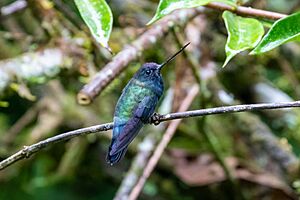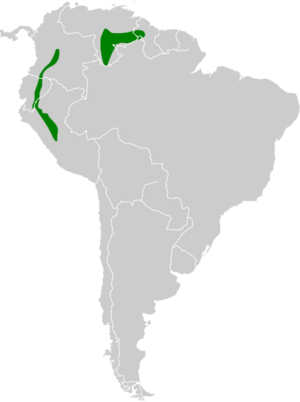Blue-fronted lancebill facts for kids
Quick facts for kids Blue-fronted lancebill |
|
|---|---|
 |
|
| Conservation status | |
| Scientific classification | |
| Genus: |
Doryfera
|
| Species: |
johannae
|
 |
|
| Range of Doryfera johannae | |
The blue-fronted lancebill (Doryfera johannae) is a cool type of hummingbird. It belongs to the Trochilidae family. You can find this bird in several South American countries. These include Brazil, Colombia, Ecuador, Guyana, Peru, and Venezuela.
Contents
What is a Blue-Fronted Lancebill?
The blue-fronted lancebill is a small, colorful bird. It has two main types, called subspecies. These are D. j. johannae and D. j. guianensis. It is very similar to its close relative, the green-fronted lancebill.
How Does This Hummingbird Look?
This hummingbird is about 9.6 to 11 centimeters (about 4 inches) long. Males usually weigh 3 to 5 grams. Females are a bit heavier, weighing 3.3 to 6 grams. Both male and female lancebills have a long, straight bill. Sometimes, their bill curves slightly upwards. They often hold it pointing up!
Male birds of the D. j. johannae type have a bright violet forehead. Their neck is bronze, and their upper body is a dark bronzy green. Their tail is short and blue-black. Their belly and chest are blue-black, with a shiny bluish-green on the throat.
Female birds of this type look a bit different. They have a greenish-blue forehead. Their underparts are a dull grayish bronzy green. Both male and female D. j. guianensis birds have a shorter bill. They are also a bit lighter in color overall.
Where Do Blue-Fronted Lancebills Live?
The D. j. johannae subspecies lives on the eastern side of the Andes mountains. You can find them from central Colombia down through Ecuador to Peru. They prefer wet forests on mountain slopes and in the lowlands nearby. They like ravines, gorges, and rocky areas. These birds usually stay in the middle or upper parts of the forest. However, they might go down to the bushes at the forest edges. They mostly live at heights between 800 and 1200 meters (about 2,600 to 3,900 feet).
The D. j. guianensis subspecies lives in a separate area. This includes southeastern Venezuela, western Guyana, and northern Brazil. They live in tropical and subtropical forests on flat-topped mountains called tepuis. They are usually found at higher elevations, between 900 and 2000 meters (about 2,950 to 6,560 feet). They do not live in the lowlands between these mountains.
How Do They Behave?
Movement and Travel
Blue-fronted lancebills usually stay in one place. However, they might move up or down the mountains depending on the season.
What Do They Eat?
These hummingbirds mainly eat nectar from flowers. They also catch small arthropods, like insects. They get nectar from long, tube-shaped flowers, especially those that hang down. They usually do not fight over their feeding spots. They catch insects while flying or by hovering near plants.
Breeding and Nests
The breeding season for these birds changes depending on where they live. Scientists have not studied it much. Only one nest has been described in detail. This nest was shaped like a cylinder. It was made of moss and spider silk. It had a cup at the top and hung from a rock in a small cave.
What Sounds Do They Make?
The song of the blue-fronted lancebill has not been fully described. It seems no one has recorded it yet! When they are looking for food, they make "thin, dry, chittering notes." It sounds like 'chuert'.
Are Blue-Fronted Lancebills Safe?
The IUCN (International Union for Conservation of Nature) says the blue-fronted lancebill is of "Least Concern." This means it is not currently in danger of disappearing. However, we do not know how many of these birds exist. Their numbers are thought to be going down.
Many forests where the D. j. johannae subspecies lives have been cut down. But the habitat for D. j. guianensis is mostly still there. These birds are "uncommon to fairly common" in good forest areas. They seem to handle some local changes, like when people selectively cut down trees.


